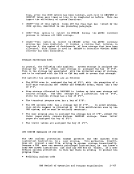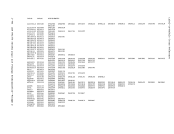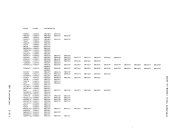in the AB option table. If STXIT AB is not active, both the address of
the new AB routine and the address of the save area are placed in the
option table.by DMSDOS ••• signals the completion of a system event. SVC 50: Handled by DMSDOS ••• issues an error message and terminates the LIOCS routine when that routine is requested to
perform a function it could notperform. tl: GETVIS -- Handled by DMSDOS ••• used by VSAM to
storage;VSAM routine. Storage is obtained from the user. free storage area and the address of the
storage is returned in Register 1.§l: GETVIS. DMSDOS ••• returns storage obtained by a
Address of the area to be returned is pointed to by Register 1.nSR -- by DMSDOS ••. VSAM uses SVC 63 to
system resources are updated serially, so that two ormore attempts to modify the same data at the same time do not succeed. A table of
counters(RURTBL) is kept for system resources. These counters are
posted when a request is made for system resources. If a resource is
already in use, a return code of eight is placed in registerO. If the
resource is available, a zero is returned in RegisterO. SVC 64: RELEASE -- Handled by DMSDOS ••• VSAM uses SVC 64 to release a system resource-obtained via USE SVC. The appropriate counter in RURTEL is decremented by one each ti.e a resource is SVC 65: CDLOAD -- Handled by DMSDOS •• VSAM phase Into-storage-unless that phase has already been loaded.
If an anchor table is available, it is searched for the phase. If
the phase is found, its load pOint, entry point, and length are returned
in registers0, 1, and 14, respectively, and register 15 contains zeros.
If the phase is not found in the anchor table,DHSFCH is called to
search for it. If the phase is found in the discontiguous shared
segment, return is made tothe requestor as above.
If the phase was found, but not loaded, storage is obtained for it
via theGETVIS SVC. DMSFCH is called again to load the phase into the
storage just obtained. An anchor table is then built in the user area
(unless one already exists) and return to the caller is then made as
described above.§§: DMSDOS ••• determines whether the problem program is 0 contains zero on
return if the program is running in virtual .ode.SVC 75: DMSDOS ••• used by VSAM I/O routines to attaIn a sector number for 3330 or 3340 devices. The appropriate sector
value is calculated from input supplied in registers 1 andO. The
sector number (from0 to 127) is returned in register o. Certain DOS SVCs are treated as no-ops by CMSjDOS and other DOS/VS SVCs are Dot supported. These are listed below. 22: Handled by DMSDOS ••• provides supervisory support for the EXIT macro. The AB option of the EXIT macro provides an exit from the
abnormal tasktermination routine and continues the task.
2-146IBM VM/370 System Logic and Program Determination--Volume 2
the new AB routine and the address of the save area are placed in the
option table.
perform a function it could not
storage;
storage is returned in Register 1.
Address of the area to be returned is pointed to by Register 1.
system resources are updated serially, so that two or
counters
posted when a request is made for system resources. If a resource is
already in use, a return code of eight is placed in register
resource is available, a zero is returned in Register
If an anchor table is available, it is searched for the phase. If
the phase is found, its load pOint, entry point, and length are returned
in registers
If the phase is not found in the anchor table,
search for it. If the phase is found in the discontiguous shared
segment, return is made to
If the phase was found, but not loaded, storage is obtained for it
via the
storage just obtained. An anchor table is then built in the user area
(unless one already exists) and return to the caller is then made as
described above.
return if the program is running in virtual .ode.
value is calculated from input supplied in registers 1 and
sector number (from
abnormal task
2-146























































































































































































































































































